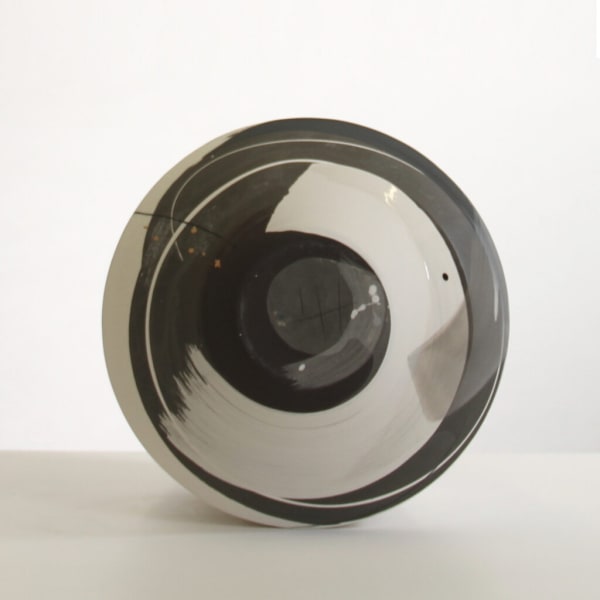-
Cavaliero Finn was first introduced to Hannah Tounsend’s ceramic sculptures by Robin Cawdron Stewart, director at Sotheby’s who has bought from the gallery previously, and for us the attraction to her work was immediate. Hannah’s ceramic sculptures are not only technically outstanding but aesthetically, they have an understated but very powerful beauty about them. Hannah’s work pushes the parameters of what can be achieved with clay by combining slip-cast and hand-thrown clay with printmaking and it’s a practice that has won her many awards.
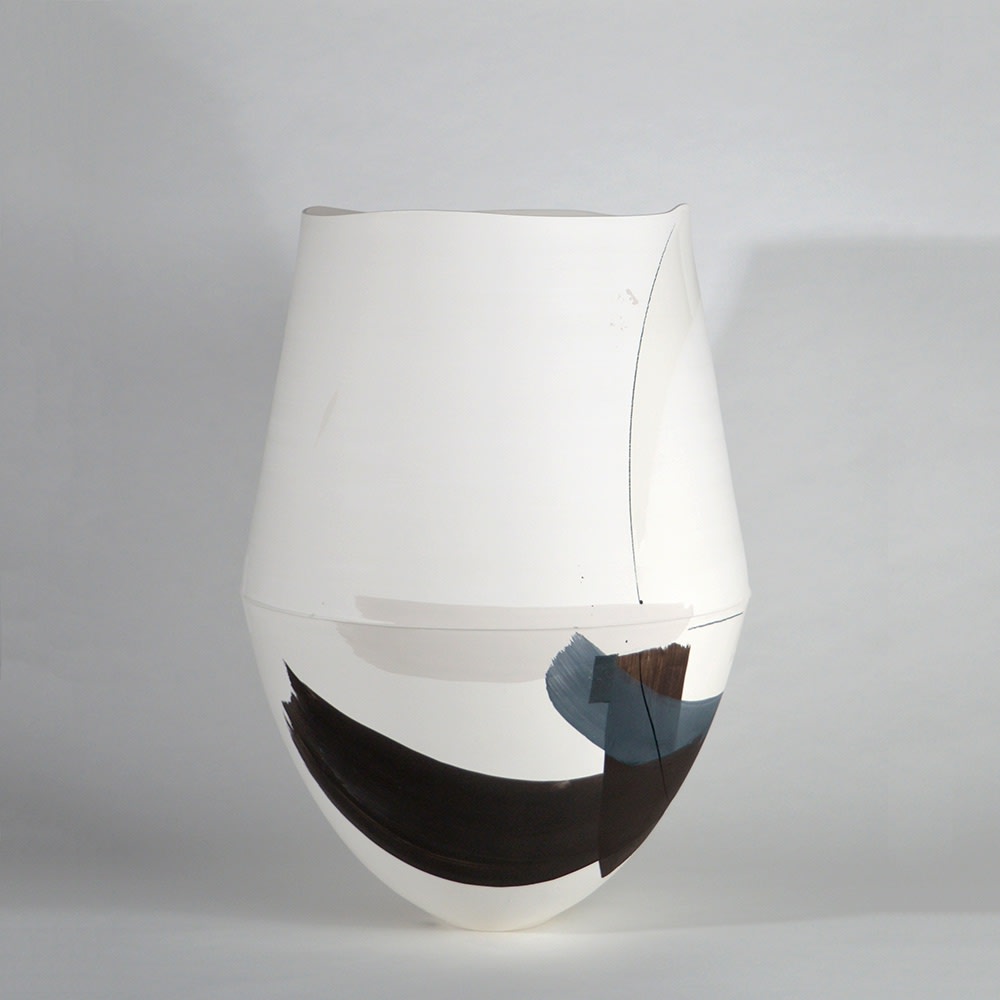
Hannah Tounsend: Large Elliptoid Vessel, approx. dimensions 360mm dia x, 600mm ht,
white earthenware with slip and underglaze decoration, 2020
Living by the coast in Lyme Regis, I was particularly drawn to Hannah’s work. There is a continuous link in the work with erosion and the remaking of the British coastline. Marks, lines and washes of colours are built up, cut through and dissolved away. The layers and repeated working of marks on her vessels explore the sea-washed, weatherworn surfaces of the coast. The vessels themselves are made with time-consuming methods, building layers of printed, poured and painted casting slips, overlaying colours on the porous surface.
“My ceramic vessels are inspired by the British shoreline and are heavy with the banding of this tiered landscape. The static, cast portions of my pieces are representative of solid land; the flowing, thrown section a liquid tide. In this way, the horizontal boundaries within my vessels echo and resonate with the elemental strata of the coast.”
Hannah Tounsend
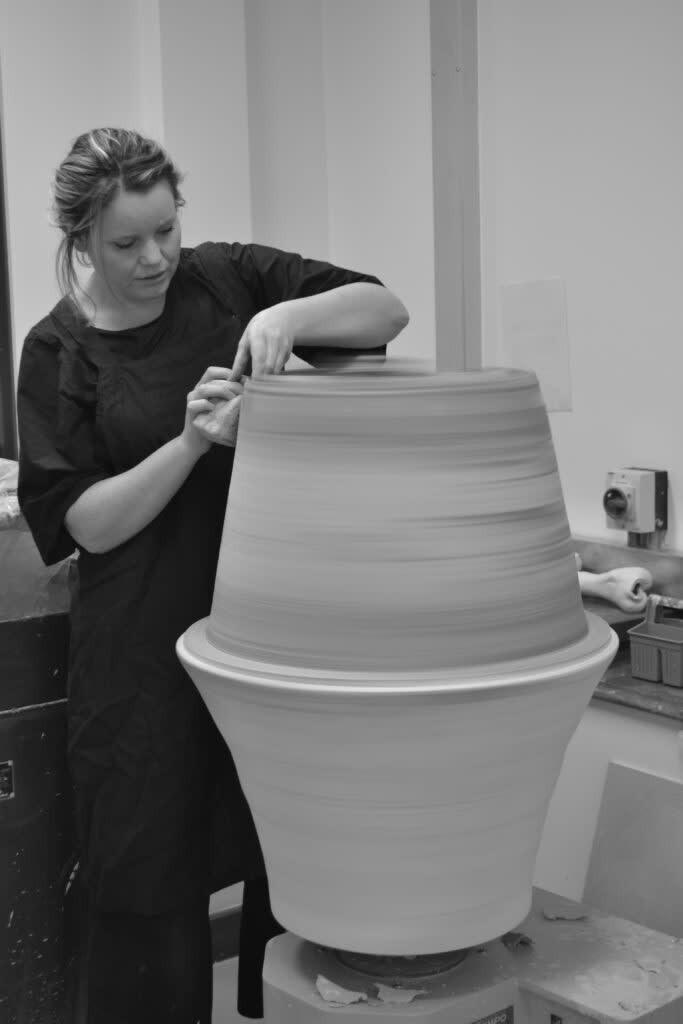
Hannah creating a Statement Vessel using her hybrid technique, hand throwing the clay
on top of a slip cast base which has itself been inlaid with her chosen design.
Hannah trained at De Montfort University for a BA Hons in Ceramics and Glass, before going on to complete her MA Fine Art with Distinction. She has exhibited internationally, with recent solo shows at the Contemporary Ceramics Centre, the National Centre for Craft and Design and the Guldagergaard International Ceramic Research Centre in Denmark. She has been included in the British Ceramic Biennial in Stoke-on-Trent three times since 2015, being awarded numerous prizes, including FRESH at the British Ceramics Biennial (2015), New Designers One Year On Award at the New Designers, Islington (2016) and the Newcomer Award at Ceramic Art London (2018).
Hannah’s innovative techniques were highlighted last year when she was selected as one of ten artists for AWARD, the British Ceramics Biennial’s exhibition and prize which celebrates excellence, innovation and creative ambition in the industry.
"AWARD is a showcase for ground-breaking and progressive practice, capturing the breadth and dynamism of artists engaging with clay today. It is an opportunity for ambition, and for new ideas to be explored and presented in a truly remarkable and historic location.Alun Graves
– Senior Curator, Ceramics and Glass at the Victoria and Albert Museum and chair of AWARD selection panel
Cavaliero Finn was the first gallery to represent Hannah’s work at Collect, The Crafts Council’s International Art Fair for Modern Craft and Design, earlier this year.
-
Hannah Tounsend: Large Angled Vessel, approx. 220mm dia x 210mm ht, white earthenware with slip and underglaze decoration, 2020
-
This week we caught up with Hannah after she sent us news of her latest body of work, a series of Angled Vessels (pictured above), which she has created during the lockdown and which are now available in our online shop.

Hannah Tounsend: Print beaker, approx. 100 dia x 100 mm ht, white earthenware with slip and underglaze decoration, 2020. Shown alongside Green Chinese Bowl by Tony Beaver
CF: How have you coped during the lockdown Hannah? Has it changed the way you work?
HT: Lock-down has meant some big changes to how I work. My large city studio and new kiln were out of bounds for several months, so I retreated to the old outbuilding in my garden to make and experiment. Without assistants, my large forms were impossible to make, so I used the time to experiment with small scale works, like my new Angled Vessels, and of course to make lots of glaze tests. It’s been a real period of reflection – looking back through old sketchbooks and planning for my practice going forward.


Hannah Tounsend: Small Angled Vessel, 2020 (two viewpoints)
Approx. dimensions- 110 mm dia, 110 mm ht, white earthenware with slip and underglaze decorationCF: How did you become a ceramicist?
HT: A chance moment led me to ceramics. I was studying to become a vet when I wandered through the ceramics department of my local university on my way to somewhere else. I remember the light was flooding in from high windows, there were a few students quietly engrossed in their making and I was struck by the certainty that this was what I wanted to do. I had always loved making as a child, but as my studies had become more serious there had been less space for creativity. I left vet school the following year to do a BA in Ceramics and Glass and have never regretted my decision.

Hannah Tounsend: Pair of Chawan vessels, white earthenware with slip and underglaze decoration.
Sculptural vessels not suitable for domestic use
CF: Your work is heavily influenced by your relationship with the shoreline, how did this come about?
HT: I was born and have lived in the Midlands for much of my life. The sea for me is a destination – the first glimpse of it at the end of a long car journey is always a special moment. The shoreline is never a landscape I travel through, always one I travel to, an endpoint. For me, it is a site of observation and contemplation – somehow outside of everyday time. Over the years the pocketfuls of pebbles I carry back from the shore have been joined by camera and sketchbook. I return to the studio with records captured whilst sitting within sandy dunes, at the base of towering cliffs or in the shadow of harbour walls. Here these frozen moments, fleeting sensations and half discerned thoughts are scored and layered into the lines of my vessels and prints. The shoreline saturates these pieces; it is present in the stance and structure of forms and felt within the diffuse merging colours of surfaces.

Hannah Tounsend: Print beakers, approx dimensions,100mm dia x 100mm ht,
white earthenware with slip and underglaze decoration, 2020
Shown alongside Museum Study 18 by Tony Beaver
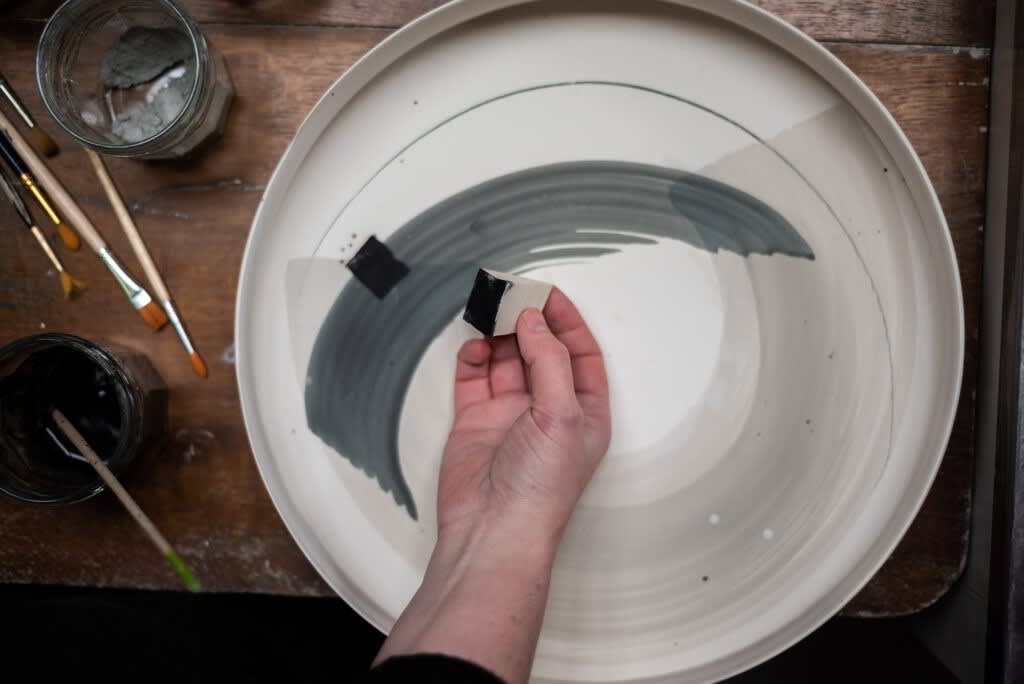
The making process
CF: Walk us through making one of your vessels… what materials and techniques do you use?
HT: My vessel pieces have emerged from the development of a hybrid making technique that combines the traditional ceramic disciplines of slip-casting and throwing. Within an open plaster mould I build layers of printed, poured and painted casting slips, overlaying colours on the porous surface.
These designs are incorporated into a cast shell of white earthenware, before mould and cast are fixed centrally to a throwing wheel. A partially thrown cylinder of plastic clay is joined to the cut rim of the still-moulded cast and fully thrown out to form the softly textured upper portion of the piece.These forms are created from two clay bodies and two making processes, they hold both a visual and literal tension. The dual aesthetic of the form is resolved with the careful placement of multilayered layered pigments, engobes* and glaze.
*a white or coloured clay slip coating applied to a ceramic body to give it decorative colour or improved texture.

Hannah Tounsend: Set of 3 Print Beakers, approx. dimensions for each - 100mm dia x 100mm ht,
white earthenware with slip and underglaze decoration, 2020
CF: At Collect earlier this year we showed your large scale statement vessels. In the making of these, what do you find most difficult? How do you manage to achieve the beautiful gestural marks inside the vessels, particularly when they are so large?
HT: Part of the challenge of working at this scale is the planning. I have to timetable each stage of the making, sanding, decorating and glazing process to make sure I have enough assistance at key points. (For example lifting the greenware piece from the half mould requires 4 people and nerves of steel!) I am lucky to have some very talented assistants to help me with this.

Hannah’s set of three eliptoid vessels seen at Collect in early March 2020.
Image by Michael HarveyHT: Throwing and shaping the top section of the vessel is probably the most difficult part of the process. In addition to the challenges of throwing at this scale, the base of the piece is still enclosed within a mould so I am refining a form that is partly unseen.
In terms of the markmaking, it is important that the scale of the mark is appropriate to that of the vessel. When working on my smaller pieces the movements of brush and pencil come from the wrist, but with the statement forms these movements need to come from the shoulder to give smooth, unbroken sweeps of pigment. Once the first mark is made it dictates the next and as the composition builds it becomes easier to envisage the completed surface. The first mark is always nerve racking though.
When decorating the inside of these tall vessels I stand on my work surface, hovering over the rim of the piece. I sometimes need to crawl inside the form to get a mark just where I want it- it can be very undignified!

Shades of Grey – “My current interest is finding ‘half colours’;
the soft subtle tones released when ‘monochrome’ clays and pigments are deconstructed.”
CF: What role does colour play in your work?
HT: I am fascinated by ceramic colour; testing and developing pigments that can be built into delicately-muted clay surfaces has been a constant and central focus of my practice. My current interest is finding ‘half colours’; the soft subtle tones released when ‘monochrome’ clays and pigments are deconstructed. By flexing variables such as pigment concentration, the thickness of application and firing temperature I can create a visual catalogue of graduated, diffuse transitions. Fine layers of slips, washes of stains and subtly tinted glazes can then be built up into a complex final hue.
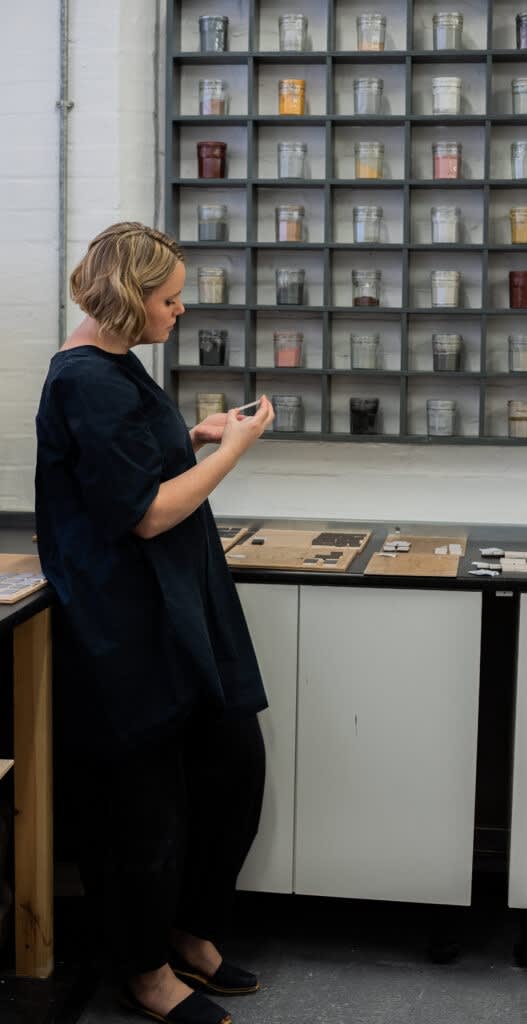
Hannah’s work is thoroughly researched and methodically documented.
”All ceramic artists have to engage with the practice of testing, the transformative nature of clay means that the colours and surfaces we see as we are making are rarely those of the finished piece.”
CF: Is your work in 2d a precursor to your ceramic work or does it exist to have a sole existence? Tell us about this part of your practice?
HT: The two disciplines of ceramics and printmaking are inextricably linked in my work. Initially, my paper monoprints were created as a way to explore surface and mark-making; confined to my sketchbooks they were precursors to ceramic outcomes. However, I quickly came to view these 2d pieces as works in their own right and to present them alongside my vessels with equal significance. The dual nature of my practice has driven much of my development as an artist. Over the years the conventions, tools and techniques of the print room have marked my ceramic work, whilst aspects of working with clay have widened my approach to print. This crossover has resulted in richer, more complex ceramic, paper and canvas surfaces than I could have otherwise achieved.
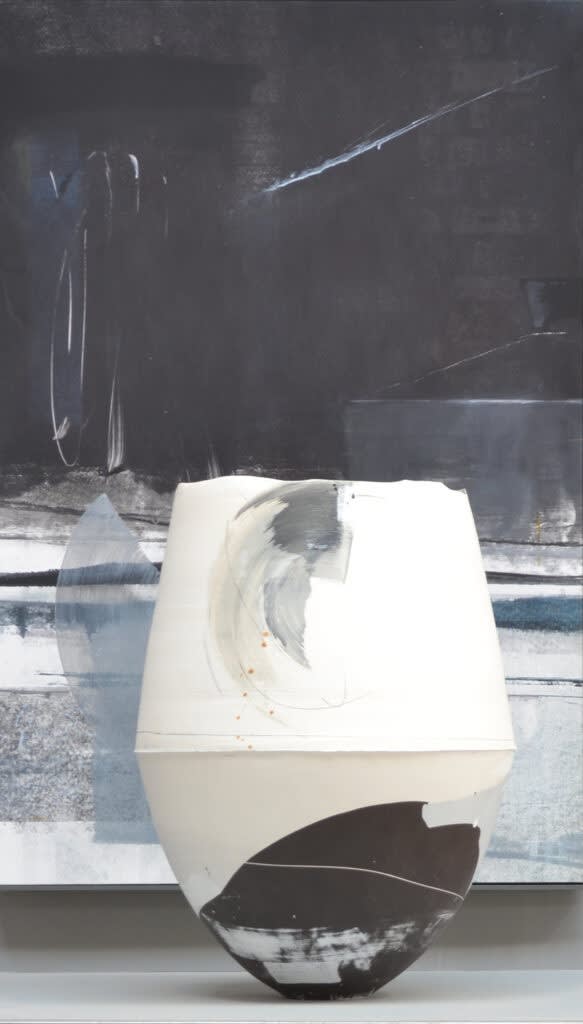
Statement Vessel and Canvas by Hannah Tounsend
CF: As the lockdown eases and the tourism industry opens up, if you could head to the coast for a short staycation, which coastline would you first visit and why?
HT: I’d make a pilgrimage to St Ives in Cornwall, I think. After months of driving no further than the local supermarket, travelling to this far-flung edge of the country really appeals. I’ve always loved this small, fishing town with its many bays backed by steeply rising cottages. In fact, the first ceramic colours I developed back when I was doing my BA were based on a palette taken from this singular stretch of coast.

Porthgwidden Beach, St Ives, Cornwall
CF: We hope you can escape to Cornwall very soon Hannah. Thanks for talking to us today.


